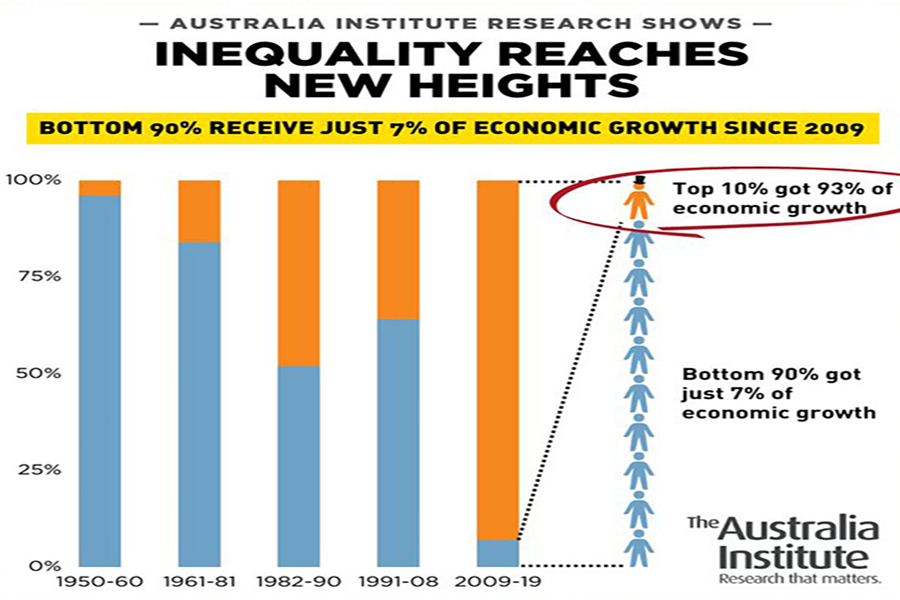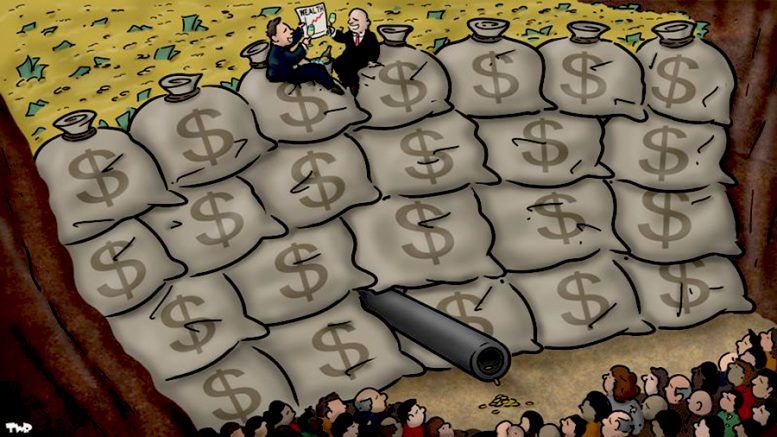Contributed by Joe Montero
Within a lacklustre economy, the Australian government is facing a situation that calls for growing intervention to do something about the reality of growing inequality. This is at a time when the ability to raise public revenue is contracting as well.
Let’s look at the first part. Any serious research reports in recent years have shown clearly that there has been a growing divide between the few wealthiest and everyone else, and this divide is getting bigger now. A part of this is the impact of inflation, stagnant wages, and miserable Centrelink payments. They combine to form a cost of living crisis.
Australian household budgets have shifted in spending pattern. Spending on essentials like housing, food, health, and education has increased, while spending on non-essentials has fallen. This means that households ae tightening their belts.
But this doesn’t reveal all.
A report released this week by the Australia Institute, and called Inequality on Steroids, spells out the extent to which this has become a reality in Australia. Its main finding is that is the period mentioned above the richest 10 percent of the population got 93 percent of the wealth gains created in the Australian economy. It goes on to say that this increased wealth is the result of policies and practices designed to increase productivity in the workplace.

This was supposed to generate more jobs and lead to rising incomes for everyone. This failed to materialise and, unfortunately, government policy and procedures have remained wedded to the belief that this must continue and ignore the evidence.
Take the 2021 global survey by the International Monetary Fund (IMF), which provided overwhelming evidence that the product has not only been worsening inequality for nations taking on this approach. Austerity is associated with poorer economic performance they said. This was backed in the same year by World Economic Forum (IMF).
A Report released by the University of New South Wales and the Australian Council of Social Service, Poverty in Australia: Who is Affected, uses data from the Australian Bureau of Statistics (ABS), to show that inequality is continuing to grow. By 2020 one in eight Australians were living below the poverty line, described as m $489 per week for a single person and $1,027 for a couple. This is over 3 million. This is the worst part of it.
A much bigger proportion of Australia is trying to make ends meet on incomes not too much higher than this poverty line, which is becoming increasingly meaningless with inflation and the associated rising cost of living. If 10 percent get the economic gains, it means that that 90 percent get little or nothing. They are falling backwards.

For the viewpoint of the majority of Australia, the existing distribution of income doesn’t work in their favour, and there is an urgent need to do something about this.
Part of the answer is to address the market failure, and the other part is that doing this requires government intervention, which in turn, means the existence of enough revenue to get on with the job of making a real difference. In the first place, this calls for a redistribution of income downwards. One way to do this is through the taxation system.
But the current Albanese government continues the habit of being hooked into going ahead with the stage-three tax cut for the wealthy devised by the previous Morrison government. By not going ahead with it, the government could halve the projected budget deficit of $50 billion. This comes out in a new report by the Grattan Institute. More could be saved by turning away from spending $368 billion on nuclear submarines. Even more could be raised by closing the top end tax evasion industry.
Given these possibilities, Australia really doesn’t have a budget deficit problem. There is just an insufficient revenue problem that can be solved.
Increasing revenues would give the government a lot more room to lower the tax on smaller incomes, and provide the means to build government services, to take some of the load of the cost of living. It would provide the means to create much more affordable housing, and to increase Centrelink payments to a realistic liveable level.
By raising needed revenues, the government could help to build the economy, restore manufacturing, create jobs, and develop new sustainable technologies and markets for Australian produce.
All it needs is the political will.


Be the first to comment on "The government must address Australia’s growing inequality"